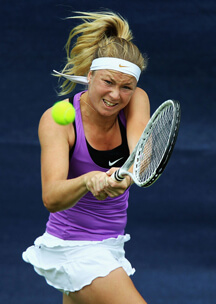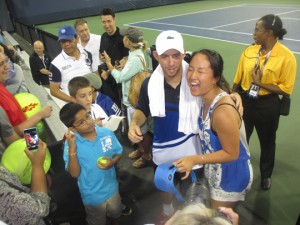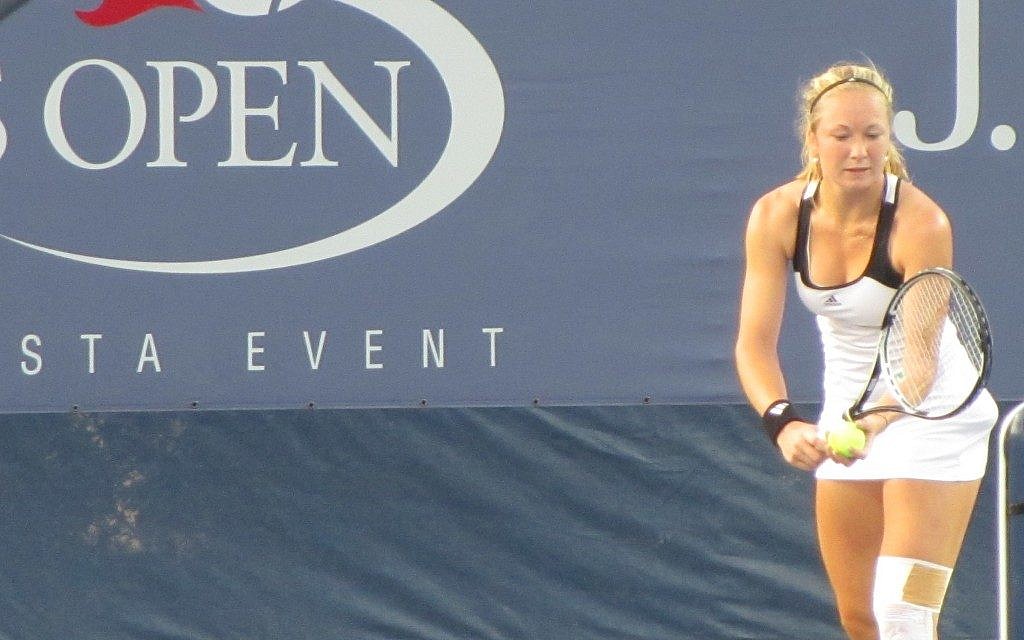FLUSHING, New York – A handful of Israeli players fought for the chance to qualify for the prestigious U.S Open Grand Slam tennis tournament, which began plan on August 26 and will wrap up on Sept. 9. The U.S. Open is the world’s highest attending sporting event, with more than 700,000 fans expected to attend.
Dudi Sela, ranked 76 in the world and a member of Israel’s Davis Cup team, automatically qualified for the main draw of the tournament. In the week leading up to the Open, Sela participated in an Israel Tennis Center clinic in Manhattan, playfully rallyng with New York Junior Tennis League tennis students, as well as with nine-year-old Israeli hopeful Neria Yona. Sela arrived a week early to the Open to practice with his coach and other main draw players, and to watch countryman Amir Weintraub’s third round qualifying match. Sela won two Challenger tournaments this summer and has acclimated to his new Wilson Blade tennis racket; he switched rackets several months ago and reports, “I had a tough time getting adjusted to my new racket.”
On opening day, Sela took on Andrey Kuznetsov of Russia in a nail-biting match. Sela was down 4-1 in the first set, but battled back to take it 7-6. He then won the second set 6-3, but lost next two sets 6-7 and 5-7. With the men tied at two sets each – and with his countrymen and Open doubles players Andy Ram and Yoni Erlich in the stands – Sela won the fifth set 6-4 for the match. Exhausted, he fell to the ground, then stood up and proceeded to pose with every single fan seeking a photo and/or an autograph.

Julia Glushko, who played in last year’s U.S. Open and is currently ranked 128, battled her way through three matches in the qualifiers to earn a spot on the main draw. She won her first match on August 27 against 20th seed Nadia Petrova of Russia. While Glushko needed three qualifying round wins to make the main draw, coach Liran Kling, in an interview with the Ledger following her first round qualifiers match, noted proudly, “Now, people expect Julia to qualify [for the main draw of major tournaments]; it is not like last year when she was a surprise.”
Weintraub, ranked 188 and also a member of the Davis Cup team, spent three weeks in New England this summer playing for the Boston Lobsters World Team Tennis team. He won two matches in the qualifying tournament, which took place the week before the Open, but in the third round match, a 6-4, 6-2 loss to Argentinean Maximo Gonzalez prevented him from making the main draw.
Shahar Peer, ranked 79 and coming off her first tournament win in four years with a victory over 19-year-old Saisai Zheng of China at the Caoxijiu Suzhou Ladies Open, was the number one seed in the qualifiers. Peer, whose up and down career has taken her as high as number 11 in the world, suffered a disappointing 6-4, 7-6 defeat in the first round of the qualifiers to Russian Ksenia Pervak.
Also getting ready for their first-round matches, as the Ledger went to press, were doubles partners Ram and Erlich, as well as Shahar Peer, who was scheduled to play womens doubles. One Israeli junior, Or Ram-Harel, may attempt to qualify for the juniors main draw.
Once again this year, kosher tennis fans will be able to feast at the open, thanks to New Jersey resident Jonathan Katz, owner and operator of Kosher Sports, and his staff, who will be operating a cart outside of court 12.

“This is our tenth U.S. Open,” Katz told the Ledger. Among the items diners will find on his cart: chipotle chicken wrap, crispy chicken wrap, Italian sausage with peppers and onions, sliced steak sandwich, knishes, franks, and overstuffed pastrami sandwiches. All meats are Glatt kosher and all breads are Pas Yisrael; the cart is under supervision of the Star-K and will be open each day of the Open, except Shabbat and Rosh Hashanah.
Katz was not particularly concerned about loss of business due to the Jewish holidays. “We’ve had Rosh Hashanah fall during the US Open before. He says, “The main factor affecting sales is the weather!” The cart closes at 4 pm on Fridays. Katz concludes, “We are looking forward to another successful US Open!”
(Source: http://www.jewishledger.com)

